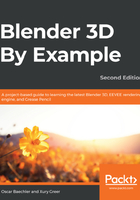
Materials and textures
We can add color to our 3D models with a mixture of materials and textures. Materials are used to determine how light behaves when it interacts with the surface of the object. Does it look like glass? Metal? Skin? Textures are 2D images that are wrapped onto a 3D model, sort of like a candy wrapper. To make our textures line up with the model, we have to unwrap the model first. Unwrapping gives us a 2D representation of the model called a UV map (or UVs). An example of this can be seen in the following image:

Once we have UVs, we can paint a texture that will be wrapped back onto the model, as shown here:

They are called UVs because all of the pieces have a U coordinate and a V coordinate, which are used to determine their positions in 2D space (very similar to graphing data on a 2D graph). Since we already used X, Y, and Z for our three-dimensional axes, our two-dimensional axes are labeled U and V. We will cover UVs, materials, and textures in detail in later chapters.